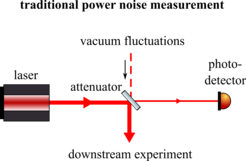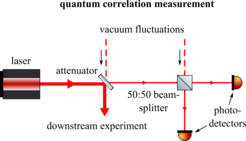Quantum correlation measurement of power fluctuations
The ‘quantum correlation measurement’ (QCM) technique investigated here presents a simple alternative for out-of-loop laser power noise detection.

Measuring and monitoring technical laser power fluctuations is essential for high precision metrology applications such as gravitational wave detectors. Since these devices often utilize high laser powers (in the range of hundreds of Watts) and commonly used high performance photodetectors saturate or get damaged at these large thermal loads, the beams usually have to be strongly attenuated for the detection.
However this also reduces the desired information of the power fluctuations compared to vacuum fluctuations coupling in at the detection port, which leads to an increased relative shot noise. This in turn then limits the power noise detection for a given amount of detected power. Although there are ways of circumventing this problem, for example by using an array of multiple photodiodes in order to increase the detected power or by employing a filter cavity for a carrier attenuation (so called ‘optical AC coupling’), these solutions come at relatively large technical effort. The ‘quantum correlation measurement’ (QCM) technique investigated here presents a simple alternative for an out-of-loop power noise detection.
In a traditional measurement, the power noise of the laser can be quantified via a power spectral density (PSD) measurement of the photodetector signal, however in this situation the shot noise and even electronic detector dark noise present detection limits. In contrast to that, the QCM setup includes a 50:50 beamsplitter placed in the detection port so that the light is split onto two photodetectors, rather than just a single one.

At the open port, vacuum fluctuations couple in similar as at the attenuator, however this contribution appears of opposing phase on the two photodetectors due to the phase shift induced by the beamsplitter. The laser power noise can then be retrieved via the cross power spectral density (CSD) of the two photodetector signals, in which the contributions of vacuum fluctuations transmitted from the original beam, and the ones coupling in at the two open ports in the detection path cancel due to their opposing phase, which leaves the measurement insensitive to shot noise.
Therefore, one can measure technical power fluctuations below the shot noise limit of the detection beam, which is not possible in the traditional approach. Furthermore, due to the fact that the individual detector dark noise contributions are uncorrelated to one another, one is also insensitive to electronic dark noise.
Overall, the QCM principle presents a powerful and easy to apply out-of-loop power noise detection.
In the QCM experiment, the aim is to quantify the feasibility of the technique in realistic circumstances for high laser power applications. Additionally, it shall be investigated if this approach can be used as a reliable detector for bright squeezed light.

